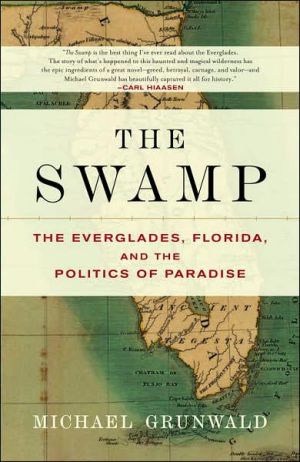The Swamp: The Everglades, Florida, and the Politics of Paradise
The Everglades was once reviled as a liquid wasteland, and Americans dreamed of draining it. Now it is revered as a national treasure, and Americans have launched the largest environmental project in history to try to save it. The Swamp is the stunning story of the destruction and possible resurrection of the Everglades, the saga of man's abuse of nature in southern Florida and his unprecedented efforts to make amends. Michael Grunwald, a prize-winning national reporter for The Washington...
Search in google:
The Everglades was once reviled as a liquid wasteland, and Americans dreamed of draining it. Now it is revered as a national treasure, and Americans have launched the largest environmental project in history to try to save it. The Swamp is the stunning story of the destruction and possible resurrection of the Everglades, the saga of man's abuse of nature in southern Florida and his unprecedented efforts to make amends. Michael Grunwald, a prize-winning national reporter for The Washington Post, takes readers on a riveting journey from the Ice Ages to the present, illuminating the natural, social and political history of one of America's most beguiling but least understood patches of land.The Everglades was America's last frontier, a wild country long after the West was won. Grunwald chronicles how a series of visionaries tried to drain and "reclaim" it, and how Mother Nature refused to bend to their will; in the most harrowing tale, a 1928 hurricane drowned 2,500 people in the Everglades. But the Army Corps of Engineers finally tamed the beast with levees and canals, converting half the Everglades into sprawling suburbs and sugar plantations. And though the southern Everglades was preserved as a national park, it soon deteriorated into an ecological mess. The River of Grass stopped flowing, and 90 percent of its wading birds vanished.Now America wants its swamp back. Grunwald shows how a new breed of visionaries transformed Everglades politics, producing the $8 billion rescue plan. That plan is already the blueprint for a new worldwide era of ecosystem restoration. And this book is a cautionary tale for that era. Through gripping narrative and dogged reporting,Grunwald shows how the Everglades is still threatened by the same hubris, greed and well-intentioned folly that led to its decline. Michael Grunwald is a reporter at The Washington Post. He has won the George Polk Award for national reporting, the Worth Bingham Prize for investigative reporting, and many other awards. He lives in Miami with his wife, Cristina Dominguez. Visit his website at www.michaelgrunwald.com. The New York Times - William Grimes Mr. Grunwald, a terrific writer, moves along at a cracking pace. The dredges dig, the railroad advances, the politicians scheme and the dreamers paint their Technicolor fantasies. There is a feverish quality to the endless engineering assaults, the mad plans to rechannel the circulatory system of the Everglades, the blind determination to ignore the forces of nature. For example, no one quite understood that South Florida often experienced powerful hurricanes, so hundreds of poor farmers died in 1926 and 1927 when Lake Okeechobee overflowed.
Introduction\ "A Treasure for Our Country"\ On December 11, 2000, the Supreme Court heard oral arguments in George W. Bush, et al. v. Albert Gore Jr., et al., the partisan battle royale that would end the stalemate over the Florida recount and send one of the litigants to the White House. The deadlocked election had exposed a divided nation, and pundits were describing Governor Bush's "Red America" and Vice President Gore's "Blue America" as if they were separate countries at war. After five weeks of ferocious wrangling over "pregnant chads" and "hanging chads," hard-liners in both camps were warning of an illegitimate presidency, a constitutional crisis, a bloodless coup.\ Inside the Court's marble-and-mahogany chambers, Senator Robert Smith of New Hampshire watched the legal jousting with genuine awe. Smith was one of the hardest of Red America's hardliners, a passionate antiabortion, antigay, antitax Republican, and he believed he was watching a struggle for the soul of his country. Smith was also a former small-town civics teacher, less jaded than most of his colleagues in Congress, and Bush v. Gore was a civics lesson for the ages, a courtroom drama that would decide the leader of the free world. "It doesn't get any bigger than this," he thought.\ But less than an hour into the proceedings, Smith suddenly walked out on history, squeezing his six-foot-five, 280-pound frame past his perplexed seatmates. "Excuse me," he whispered. "Excuse me." A bear of a man with fleshy jowls, a bulbous nose, and a sloppy comb-over, Smith could feel the stares as he lumbered down the center aisle, then jostled through the hushed standing-room crowd to the exit. "Excuse me. Excuse me."\ Smith's abrupt departure looked like one of his unorthodox protests, like the time he brandished a plastic fetus on the Senate floor, or the time he announced he was resigning from the Republican Party because it was cutting too many big-government deals with the Democrats. Smith was an unabashed ideologue, rated the most conservative and the most frugal senator by various right-wing interest groups. He had voted against food stamps and Head Start, clamored for President Bill Clinton's impeachment, and even mounted his own quixotic campaign for president on a traditional-values platform.\ But this was no protest. Smith was rushing to the White House, to celebrate a big-government deal with the Democrats.\ At the height of the partisan war over the Florida recount, President Clinton was signing a bipartisan bill to revive the Florida Everglades, a $7.8 billion rescue mission for sixty-nine endangered species and twenty national parks and refuges. It was the largest environmental restoration project in the history of the planet, and Smith had pushed it through Congress with classic liberal rhetoric, dismissing its price tag as "just a can of Coke per citizen per day," beseeching his colleagues to "save this treasure as our legacy to our children and grandchildren." So after his dash from the Court, he headed straight to the Cabinet Room, where he exchanged congratulations with some of the Democratic Party's top environmentalists, like Interior Secretary Bruce Babbitt, the former head of the League of Conservation Voters, and White House aide George Frampton, the former head of the Wilderness Society. And Smith was not even the most surprising guest in the West Wing that day.\ That was Florida's Republican governor, another key supporter of the Everglades plan, a former Miami developer named Jeb Bush. As the world waited to hear whether his brother would win his state and succeed their father's successor in the White House, Jeb was already there, staring out at the Rose Garden with the air of a quarterback who had stumbled into the opposing locker room near the end of the Super Bowl. "The last time I was here, your father was president!" one lobbyist told him. Jeb tried to smile, but it came out more like a grimace. One Clinton appointee began babbling about the Cuban Missile Crisis — possibly the last time that room had felt that tense. Jeb even said hi to a Miami congresswoman who had publicly accused him of suppressing black votes. "This," thought Jeb's top environmental aide, "is as surreal as politics can get."\ Unless, that is . . . but no, Vice President Gore, a key architect of the Everglades plan, stayed home to listen to the Supreme Court audiotape. "I was really proud of what we accomplished in the Everglades," Gore later recalled. "But I was in a pretty pitched battle that day."\ At 1:12 P.M., an ebullient President Clinton invited everyone into the Oval Office, the room that George W. Bush liked to say needed a good scrubbing. If the president was upset about Gore's plight, or Jeb's presence, or the legacy of impeachment, or his imminent move to the New York suburbs, the legendary compartmentalizer hid it well. "This is a great day!" he said. "We should all be very proud." He used eighteen ceremonial pens to sign the bill, graciously handing the first souvenir to Jeb. Senator Smith quipped that it was lucky Clinton's name wasn't Cornelius Snicklefritzer, or else the ceremony might never end. The president threw his head back and laughed. "Wow," thought his chief of staff, John Podesta, "this is like a Fellini movie."\ If Florida's political swamp was tearing Americans apart, Florida's actual swamp had a knack for bringing people together. The same Congress that had been torn in half by Clinton's impeachment had overwhelmingly approved his plan for the Everglades, after lobbyists for the sugar industry and the Audubon Society walked the corridors of Capitol Hill arm-in-arm. The same Florida legislature that was in turmoil over Bush v. Gore had approved Everglades restoration without a single dissenting vote.\ At a press conference after the ceremony, Jeb sidestepped the inevitable Bush v. Gore questions to highlight this unity: "In a time when people are focused on politics, and there's a little acrimony — I don't know if y'all have noticed — this is a good example of how, in spite of all that, bipartisanship is still alive." Reporters shouted follow-ups about the Court, but the governor cut them off with a smile. "No, no, no, no, you're going the wrong way on that one. We're here to talk about something that's going to be long-lasting, way past counting votes. This is the restoration of a treasure for our country."\ The Test\ Today, everyone agrees that the Everglades is a national treasure. It's a World Heritage Site, an International Biosphere Reserve, the most famous wetland on earth. It's a cultural icon, featured in Carl Hiaasen novels, Spiderman comics, country songs, and the opening credits of CSI: Miami, as well as the popular postcards of its shovel-faced alligators and spindly-legged wading birds. It's the ecological equivalent of motherhood and apple pie; when an aide on NBC's The West Wing was asked the most popular thing the president could do for the environment, he immediately replied: "Save the Everglades."\ But there was once just as broad a national consensus that the Everglades was a worthless morass, an enemy of civilization, an obstacle to progress. The first government report on the Everglades deemed it "suitable only for the haunt of noxious vermin, or the resort of pestilential reptiles." Its explorers almost uniformly described it as a muddy, mushy, inhospitable expanse of razor-edged sawgrass in shallow water — too wet to farm, too dry to sail, too unpredictable to settle. Americans believed it was their destiny to drain this "God-forsaken" swamp, to "reclaim" it from mosquitoes and rattlesnakes, to "improve" it into a subtropical paradise of bountiful crops and booming communities. Wetlands were considered wastelands, and "draining the swamp" was a metaphor for solving festering problems.\ The heart of the Everglades was technically a marsh, not a swamp, because its primary vegetation was grassy, not woody; the first journalist to slog through the Everglades called it a "vast and useless marsh." But it was usually described as a dismal, impenetrable swamp, and even conservationists dreamed of draining it; converting wet land into productive land was considered the essence of conservation. Hadn't God specifically instructed man to subdue the earth, and take dominion over all the living creatures that moveth upon it? Wasn't America destined to overpower its wilderness?\ This is the story of the Everglades, from useless bog to national treasure, from its creation to its destruction to its potential resurrection. It is the story of a remarkable swath of real estate and the remarkable people it has attracted, from the aboriginals who created the continent's first permanent settlement in the Everglades, to the U.S. soldiers who fought a futile war of ethnic cleansing in the Everglades, to the dreamers and schemers who have tried to settle, drain, tame, develop, sell, preserve, and restore the Everglades. It's a story about the pursuit of paradise and the ideal of progress, which once inspired the degradation of nature, and now inspires its restoration. It's a story about hubris and unintended consequences, about the mistakes man has made in his relationship with nature and his unprecedented efforts to fix them.\ The story begins with the natural Everglades ecosystem, which covered most of south Florida, from present-day Orlando all the way down to the Florida Keys. For most of its history, it was virtually uninhabited. As late as 1897, four years after the historian Frederick Jackson Turner declared the western frontier closed, an explorer marveled that the Everglades was still "as much unknown to the white man as the heart of Africa."\ But once white men got to know it, they began to transform it. A Gilded Age industrialist named Hamilton Disston was the first visionary to try to drain the swamp. A brilliant oilman-turned-developer named Henry Flagler considered his own assault on the Everglades while he was laying the foundation for modern south Florida. And an energetic Progressive Era governor named Napoleon Bonaparte Broward vowed to create an Empire of the Everglades with more canals, declaring war on south Florida's water.\ The Everglades turned out to be a resilient enemy, resisting man's drainage schemes for decades, taking revenge in the form of brutal droughts and catastrophic floods, converting Florida swampland into an enduring real estate punchline. In 1928, a hurricane blasted Lake Okeechobee through its flimsy muck dike and drowned 2,500 people in the Everglades, a ghastly foreshadowing of Hurricane Katrina's assault on New Orleans. Mother Nature did not take kindly to man's attempts to subjugate her.\ But the U.S. Army Corps of Engineers, the ground troops in America's war against nature, finally conquered the Everglades with one of the most elaborate water-control projects in history, setting the stage for south Florida's spectacular postwar development. Suburbs such as Weston, Wellington, Plantation, Pembroke Pines, Miami Lakes, and Miami Springs all sprouted in drained Everglades wetlands. So did Miami International Airport, Sawgrass Mills Mall, Florida International University, Burger King corporate headquarters, and a vast agricultural empire that produces one out of every five teaspoons of American sugar. Disney World was built near the headwaters of the Everglades. And some people began to wonder whether the creation of a man-made paradise across Florida's southern thumb was worth the destruction of a natural one.\ So the story of the Everglades is also the story of the transformation of south Florida, from a virtually uninhabited wasteland to a densely populated Fantasyland with 7 million residents, 40 million annual tourists, and the world's largest concentration of golf courses. "There has never been a more grossly exaggerated region, a more grossly misrepresented region, or one concerning which less has been known than this mighty empire of South Florida," the Palm Beach Post said in 1924. That's still about right.\ America's war on nature has left a tattered battlefield in south Florida. Half the Everglades is gone. The other half is an ecological mess. Wading birds no longer darken the skies above it. Algal blooms are exploding in its lakes and estuaries, massacring its dolphins, oysters, and manatees. And it is now clear that the degradation extends beyond noxious vermin and pestilential reptiles, affecting the people of south Florida as well. The aquifers that store their drinking water are under siege. Their paradise has been sullied by sprawl, and by overcrowded schools, hospitals, and highways. Most of them are at risk from the next killer hurricane — and the one after that. It is now almost universally agreed that south Florida's growth is no longer sustainable.\ The Everglades restoration plan that President Clinton signed with Governor Bush at his side is supposed to restore some semblance of the original ecosystem, and guide south Florida toward sustainability. And the Army Corps of Engineers, after decades of helping to destroy the Everglades, will lead the effort to undo some of the damage. "The Everglades is a test," one environmentalist has written. "If we pass, we may get to keep the planet."\ On that December day at the millennium's end, Republicans and Democrats described Everglades restoration as the dawn of a new era in conservation — not only for south Florida, but for mankind. Instead of taming rivers, irrigating deserts, and draining swamps, man would restore ravaged ecosystems. Instead of fighting over scarce fresh water — the oil of the twenty-first century — Floridians would demonstrate how to share. The Everglades, Jeb Bush said, would be "a model for the world," proof that man and nature could live in harmony. America's politicians would finally pass the Everglades test.\ It was a noble sentiment. But man had been flunking that test for a long time. Copyright ©2006 by Michael Grunwald
Introduction : "a treasure for our country"1Pt. 1The natural Everglades1Grassy water92The intruders243Quagmire404A new vision545Drainage gets railroaded64Pt. 2Draining the Everglades6The reclamation of a kingly domain817The father of South Florida988Protect the birds1179"Water will run downhill!"13010Land by the gallon15111Nature's revenge17612"Everglades permanence now assured"19713Taming the Everglades216Pt. 3Restoring the Everglades14Making peace with nature23915Repairing the Everglades26416Something in the water28017Something for everyone30418Endgame333Epilogue : the future of the Everglades357
\ From the Publisher"This is a wonderfully written, provocative and important book. It combines history and investigative journalism to explore not only the Everglades but the larger tensions of a society's relationship with the environment. It's also a riveting story, the definitive account of south Florida's incredible journey from natural marshland to man-made megalopolis. There are many lessons here, and in the wake of Katrina it's time we learned them." — John Barry, author of Rising Tide and The Great Influenza\ "In The Swamp, Michael Grunwald has produced a masterly narrative, a story of ambition and greed in the Everglades that is rich with character, entertainment and revelation. This is a quintessential chapter of American history and also an urgently important work of contemporary journalism." — Steve Coll, author of Ghost Wars\ "Michael Grunwald is tough and clear-eyed and writes like a dream. Here, in The Swamp, he has found the perfect story — man's long struggle between destruction and salvation, played out in the Everglades of Florida. With its interwoven threads of history, science, politics and biography, Grunwald's work has brought a beautiful, dying place to life as never before." — David Maraniss, author of They Marched into Sunlight and When Pride Still Mattered\ "Michael Grunwald digs deep and writes smart. The dying Everglades hasn't had a livelier or more compelling witness since Marjory Stoneman Douglas. The Swamp will sit cover to cover with her classic The Everglades: River of Grass on history's bookshelf." — John Rothchild, author of Up for Grabs: A Trip Through Time and Space in the Sunshine State and A Fool and His Money\ \ \ \ \ \ John G. MitchellIn recent years, writers have devoted a lot of ink to the tortured history of south Florida's Everglades. But no one has nailed that story as effectively, as hauntingly and as dramatically as Michael Grunwald does in The Swamp , a brilliant work of research and reportage about the evolution of a reviled bog into America's -- if not the world's -- most valuable wetland.\ — The Washington Post\ \ \ William GrimesMr. Grunwald, a terrific writer, moves along at a cracking pace. The dredges dig, the railroad advances, the politicians scheme and the dreamers paint their Technicolor fantasies. There is a feverish quality to the endless engineering assaults, the mad plans to rechannel the circulatory system of the Everglades, the blind determination to ignore the forces of nature. For example, no one quite understood that South Florida often experienced powerful hurricanes, so hundreds of poor farmers died in 1926 and 1927 when Lake Okeechobee overflowed.\ — The New York Times\ \ \ \ \ Publishers WeeklyWashington Post reporter Grunwald brings the zeal of his profession-and the skill that won him a Society of Environmental Journalists Award in 2003-to this enthralling story of "the river of grass" that starry-eyed social engineers and greedy developers have diverted, drained and exploited for more than a century. In 1838, fewer than 50 white people lived in south Florida, and the Everglades was seen as a vast and useless bog. By the turn of this century, more than seven million people lived there (and 40 million tourists visited annually). Escalating demands of new residents after WWII were sapping the Everglades of its water and decimating the shrinking swamp's wildlife. But in a remarkable political and environmental turnaround, chronicled here with a Washington insider's savvy, Republicans and Democrats came together in 2000 to launch the largest ecosystem restoration project in America's history. This detailed account doesn't shortchange the environmental story-including an account of the senseless fowl hunts that provoked abolitionist Harriet Beecher Stowe's 1877 broadside "Protect the Birds." But Grunwald's emphasis on the role politics played in first despoiling and now reclaiming the Everglades gives this important book remarkable heft. 18 pages of b&w photos; 7 maps. (Mar.) Copyright 2005 Reed Business Information.\ \ \ \ \ Kirkus ReviewsA lively appreciation of the Everglades as an ecosystem worthy of care and protection-quite a turnaround in attitude, as Washington Post reporter Grunwald reveals. The natural Everglades encompasses an area twice the size of New Jersey, and it lacks both immediately spectacular features and elevation: One "pass" there is marked at a mere three feet above sea level. Yet huge quantities of freshwater slowly roll down the Everglades; as Grunwald writes, "a raindrop that fell in its headwaters in central Florida could have taken an entire year to dribble down to its estuaries at the tip of the peninsula." Nineteenth-century white explorers damned the "Sea of Grass" for its heat, mosquitoes, vast store of reptiles, renegade Indians and runaway slaves, but speculators and capitalists came along who recognized a couple of salient facts: Rich in organic peat, the Everglades could be an agricultural paradise, and it could sustain whole cities. All that was needed was to remake the place entirely-drain the swamps, build vast canals and railroads, divide it into cozy lots. Grunwald's account of the con games and fly-by-nights that made modern South Florida possible is a learned entertainment, though it becomes somewhat less amusing once it's known that the same actors and forces are in play today; one illustrative moment comes when Jeb Bush, governor of Florida and brother of the president, came close to selling off Florida's water rights in the Everglades for the pittance offered by a little company called Azurix, "an aggressive new player in the $400 billion global water market"-and, as it happens, a subsidiary of Enron. Happily, the deal didn't go through. More happily still, Grunwald writes thatmany wide-ranging measures to help restore the Everglades have been successful. Still, "drive through the region's strip-mall hellscapes," Grunwald concludes, and it's clear that much remains to be done to save the Everglades. This lucid history and call to arms is an essential companion to that work.\ \








